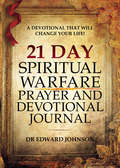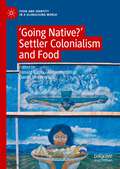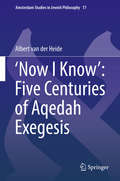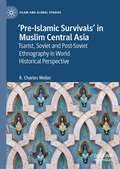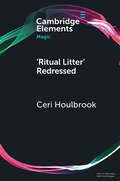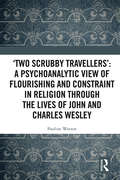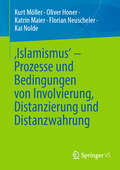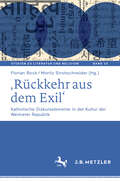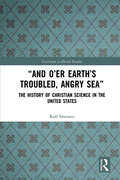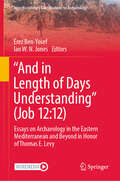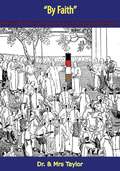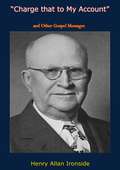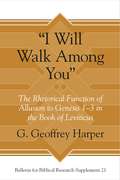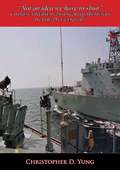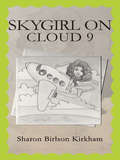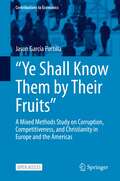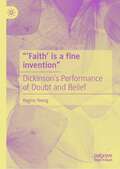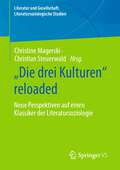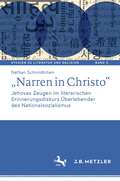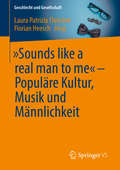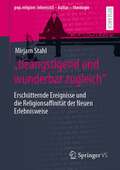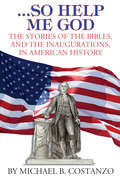- Table View
- List View
21 DAY SPIRITUAL WARFARE PRAYER AND DEVOTIONAL JOURNAL
by Edward JohnsonThe journal provides strategies to defeat Satan and his plans against the believers.
‘Going Native?': Settler Colonialism and Food (Food and Identity in a Globalising World)
by Alejandro Colás Daniel Monterescu Ronald RantaThis volume offers a comparative survey of diverse settler colonial experiences in relation to food, food culture and foodways - how the latter are constructed, maintained, revolutionised and, in some cases, dissolved. What do settler colonial foodways and food cultures look like? Are they based on an imagined colonial heritage, do they embrace indigenous repertoires or invent new hybridised foodscapes? What are the socio-economic and political dynamics of these cultural transformations? In particular, this volume focuses on three key issues: the evolution of settler colonial identities and states; their relations vis-à-vis indigenous populations; and settlers’ self-indigenisation – the process through which settlers transform themselves into the native population, at least in their own eyes. These three key issues are crucial in understanding settler-indigenous relations and the rise of settler colonial identities and states.
‘Now I Know’: Five Centuries of Aqedah Exegesis
by Albert van der HeideThis book describes how medieval Jewish Bible scholars sought to answer the question of what is meant by the Angel’s message from God to Abraham: ‘Now I Know’, as written in Genesis 22 verse 12. It examines these scholars’ comments on the nineteen verses in Genesis that tell the story of Abraham’s readiness to sacrifice his own son Isaac, the Aqedat Yiṣḥaq. It explores the answers they found to the question of what, indeed, this story is trying to tell us. Is it a drastic way to condemn the practice of child sacrifice? Does it call for replacing human sacrifices with animal sacrifices? Is it a trial by which the Almighty tests the fidelity of one of His followers? Or is it His way to show the world the nature of true belief?The book starts with an introduction to familiarize readers with the many and varied manifestations of the Aqedah theme in Jewish culture and with the developments of medieval Jewish Bible exegesis in general. Next, it offers translations and analyses of the classical medieval Jewish Bible commentaries that deal with the exegesis of Genesis 22, exploring the many angles from which the Aqedah story has been understood. No less than five centuries of medieval Aqedah exegesis are reviewed, from Saadya (882-942) to Isaac Abrabanel (1437-1508). These texts from the commentaries are combined with hermeneutical key passages by Moses Maimonides, Joseph Ibn Kaspi, Ḥasdai Crescas, and others, which were familiar to the minds of the exegetes, or which, conversely, reflect the impact of biblical Aqedah exegesis on religious thought. Together, the passages discussed illustrate the growth and development of Jewish Bible exegesis in dialogue with the rabbinic sources and with the various trends of thought and theology of their times. The consistent focus on the Aqedah constitutes a unifying theme, while the insights presented here greatly advance our understanding of the various developments in medieval Jewish Bible exegesis.
‘Pre-Islamic Survivals’ in Muslim Central Asia: Tsarist, Soviet and Post-Soviet Ethnography in World Historical Perspective (Islam and Global Studies)
by R. Charles WellerThe book traces the conceptual lens of historical-cultural ‘survivals’ from the late 19th-century theories of E.B. Tylor, James Frazer, and others, in debate with monotheistic ‘degenerationists’ and Protestant anti-Catholic polemicists, back to its origins in Jewish, Christian and Muslim traditions as well as later more secularized forms in the German Enlightenment and Romanticist movements. These historical sources, particularly the ‘dual faith’ tradition of Russian Orthodoxy, significantly shaped both Tsarist and later Soviet ethnography of Muslim Central Asia, helping guide and justify their respective religious missionary, social-legal, political and other imperial agendas. They continue impacting post-Soviet historiography in complex and debated ways. Drawing from European, Central Asian, Middle Eastern and world history, the fields of ethnography and anthropology, as well as Christian and Islamic studies, the volume contributes to scholarship on ‘syncretism’ and ‘conversion’, definitions of Islam, history as identity and heritage, and more. It is situated within a broader global historical frame, addressing debates over ‘pre-Islamic Survivals’ among Turkish and Iranian as well as Egyptian, North African Berber, Black African and South Asian Muslim Peoples while critiquing the legacy of the Geertzian ‘cultural turn’ within Western post-colonialist scholarship in relation to diverging trends of historiography in the post-World War Two era.
‘Ritual Litter' Redressed (Elements in Magic)
by Ceri HoulbrookRitual deposition is not an activity that many people in the Western world would consider themselves participants of. The enigmatic beliefs and magical thinking that led to the deposition of swords in watery places and votive statuettes in temples, for example, may feel irrelevant to the modern day. However, it could be argued that ritual deposition is a more widespread feature now than in the past, with folk assemblages – from roadside memorials and love-lock bridges, to wishing fountains and coin-trees – emerging prolifically worldwide. Despite these assemblages being as much the result of ritual activity as historically deposited objects, they are rarely given the same academic attention or heritage status. As well as exploring the nature of ritual deposition in the contemporary West, and the beliefs and symbolisms behind various assemblages, this Element explores the heritage of the modern-day deposit, promoting a renegotiation of the pejorative term 'ritual litter'.
‘Two Scrubby Travellers’: A psychoanalytic view of flourishing and constraint in religion through the lives of John and Charles Wesley
by Pauline WatsonThe ways in which people change and grow, and learn to become good, are not only about conscious decisions to behave well, but about internal change which allows a loving and compassionate response to others. Such change can take place in psychotherapy; this book explores whether similar processes can occur in a religious context. Using the work of Julia Kristeva and other post-Kleinian psychoanalysts, change and resistance to change are examined in the lives of John Wesley, the founder of Methodism, and his brother Charles, the greatest English hymn-writer. Their mother’s description of them as young men as ‘two scrubby travellers’, was a prescient expression indicating their future pilgrimage, which they negotiated through many struggles and compromises; it points towards the ‘wounded healer’, a description which could be applied to John in later years. The use of psychoanalytic thought in this study allows the exploration of unconscious as well as conscious processes at work and interesting differences emerge, which shed light on the elements in religion that promote or inhibit change, and the influence of personality factors. ‘Two scrubby travellers’: A psychoanalytic view of flourishing and constraint in religion through the lives of John and Charles Wesley enriches our understanding of these two important historical figures. It questions the categorising of forms of religion as conducive to change and so ‘mature’, and other forms as ‘immature’, at a time when many, particularly young people, are attracted by fundamentalist, evangelical forms of belief. This book will be essential reading for researchers working at the intersection of psychoanalysis and religious studies; it will also be of interest to psychotherapists and psychoanalysts more generally, and to researchers in the philosophy of religion.
‚Islamismus‘ - Prozesse und Bedingungen von Involvierung, Distanzierung und Distanzwahrung
by Oliver Honer Kurt Möller Kai Nolde Katrin Maier Florian NeuschelerWarum und wie wird jemand zu einem sogenannten Islamisten oder zu einer Islamistin? Wieso, auf welche Weise und wann erfolgen Distanzierungen von solchen Haltungen und Sozialzusammenhängen? Was sind relevante Bedingungen dafür, dass ‚islamistische‘ Ansprachen bei anderen Adressierten nicht verfangen und sie jegliche Involvierung ablehnen? Dies sind die zentralen Fragen, zu denen dieses Buch Antworten präsentiert und daraus abgeleitet Handlungsempfehlungen formuliert. Dafür fasst es den aktuellen Forschungsstand zusammen und informiert über die empirischen Befunde der an der Hochschule Esslingen von 2019 bis 2022 durchgeführten Studie Wendezeit. Es handelt sich um eine auf junge Menschen fokussierte, längsschnittlich angelegte und qualitativ-rekonstruktive Untersuchung. Sie basiert auf Interviews mit 44 ehemalig ‚islamistisch‘ involvierten Proband:innen bzw. mit solchen, die Kontakte zu ‚islamistischen‘ Kontexten hatten, aber Distanz wahrten. In ausgewählten Fällen wurden Gespräche mit Distanzierungsberater:innen und Umfeldangehörigen der Betroffenen in die Auswertung einbezogen.
‚Rückkehr aus dem Exil‘: Katholische Diskurselemente in der Kultur der Weimarer Republik (Studien zu Literatur und Religion / Studies on Literature and Religion #10)
by Florian Bock Moritz StrohschneiderDie Kultur der Weimarer Republik begeisterte sich in besonderem Maße für solche religiösen Ideen, von denen man sich Hilfe beim Umgang mit den allgegenwärtigen Krisenerfahrungen erhoffte. Auf diese Weise wanderten zahlreiche genuin katholische Überzeugungen und Positionen in den öffentlichen Diskurs ein und prägten gesellschaftliche Semantiken und Praktiken. Solche katholischen Diskurselemente, die außerhalb des gesellschaftlichen Teilsystems Religion, aus dem sie eigentlich stammen, und damit auch jenseits der katholischen Milieus wirksam und einflussreich waren, stehen im Fokus dieses interdisziplinär angelegten Bandes.
“And O’er Earth’s Troubled, Angry Sea”: The History of Christian Science in the United States (Variorum Collected Studies)
by Rolf SwensenChristian Science is one of the most unique and controversial of American religions, but there has never been a history of this influential metaphysical group, best known for its healing through prayer. Most attention has previously focused on the church’s founder, Mary Baker Eddy (1821-1910). This compilation of nine previously published scholarly articles, buttressed by additional insight presented in the preface, introduction, and conclusion, should lead to further investigation of this compelling topic.This volume investigates the origins of the Christian Science movement, illustrates how Eddy’s students -- mainly women -- helped its rapid spread through healings, how Eddy guided and restrained her students, examines some denominational growing pains, underscores how The Mother Church in Boston and Eddy’s Church Manual evolved, recounts dozens of testimonies of healing, and shows how local, or branch, churches operated before and after Eddy’s passing. Contrary to previous assumptions, the new Christian religion was surprisingly diverse, with almost one half of the membership coming from the lower middle and working classes. This vibrant church ultimately declined, due to excessive centralization and insufficient utilization of the membership, plus lack of social activities and the rise of medical science. Recent efforts to revitalize the movement through embracing communities are continuing.“And O’er Earth’s Troubled, Angry Sea”: The History of Christian Science in the United States will appeal to Christian Scientists, kindred spirits in the metaphysical world, anyone interested in religion, and those who read social history. Each chapter is suitable for group discussions and for undergraduate or graduate classes.
“And in Length of Days Understanding”: Essays on Archaeology in the Eastern Mediterranean and Beyond in Honor of Thomas E. Levy (Interdisciplinary Contributions to Archaeology)
by Ian W. N. Jones Erez Ben-YosefThis two-volume book presents cutting-edge archaeological research, primarily as practiced in the Eastern Mediterranean region. These volumes’ key foci are inspired by the work of Thomas E. Levy. Volume 1 provides an in-depth look at new archaeological research in the southern Levant (primarily in modern Israel and Jordan) inspired by Levy’s commitment to understanding social, political, and economic processes in a long-term or “deep time” perspective. Volume 2 focuses on new research in several key areas of 21st century anthropological archaeology and archaeological science. Volume 1 is organized around two major themes: 1) the later prehistory of the southern Levant, or the Neolithic, Chalcolithic, and Bronze Age, and 2) new research in biblical archaeology, or the historical archaeology of the Iron Age. Each section contains a combination of new perspectives on key debates and studies introducing new research questions and directions. Volume 2 is organized around five major themes: 1) the archaeology of the Faynan copper ore district of southern Jordan, a key region for archaeometallurgical research in West Asia where Levy conducted field research for over a decade, 2) new research in archaeometallurgy beyond the Faynan region, 3) marine and maritime archaeology, focusing on issues of trade and environmental change, 4) cyber-archaeology, an important 21st century field Levy conceived as “the marriage of archaeology, engineering, computer science, and the natural sciences,” and 5) key issues in anthropological archaeological theory. In addition to presenting the reader with an up-to-date view of research in each of these areas, the volume also has chapters exploring the connections between these themes, e.g. the maritime trade of metals and cyber-/digital archaeological approaches to metallurgy. The work contains contributions from both up-and-coming early career researchers and key established figures in their fields. This book is an essential reference for archaeologists and scholars in related disciplines working in the southern Levant and the Eastern Mediterranean.
“By Faith”: Henry W. Frost and the China Inland Mission
by Dr Howard Taylor Geraldine TaylorBy inspired definition faith is ‘being sure of what we hope for and certain of what we do not see.” By faith we are saved. By faith we are justified. By faith we please God. Though faith is central in the Christian life, we somehow are amazed when we see the vitality and power of faith at work in ordinary people’s lives. In each generation we see a special few men and women who have stretched themselves by risking everything on the sure promises of God. In the end they prove the faithfulness of their Master and challenge their own day to take their God seriously. Their stories are an encouragement to the next generation as they in turn join the ranks of that “great cloud of witnesses” who cheer us on in the life of faith.Henry W. Frost bore eloquent testimony to his generation that God was willing to bear the responsibility for a surrendered life. What Hudson Taylor was to England, Henry Frost was to North America. His strength of faith and character gave stability to the fledgling North American branch of the China Inland Mission.It has been said that courage is the power to let go of the familiar. If that is the case, the life of Henry Frost and his leadership of the North American China Inland Mission will be the most courageous biography you have ever read.
“Charge that to My Account” and Other Gospel Messages
by Henry IronsideBecause GOD has been pleased to set His seal of approval upon these simple gospel messages by using them in the awakening and salvation of sinners, they can be found here, in book form, in the earnest hope that many who read them may find joy and peace in believing!First published in 1931, Pastor H. A. Ironside’s “Charge that to My Account” and Other Gospel Messages contains 12 interesting studies, beginning with his best known gospel presentation based on Paul’s letter to Philemon, and includes “Will a Loving God Permit Anyone to Be Eternally Lost?” and “Inside the Veil, Outside the Camp.”
“I Will Walk Among You”: The Rhetorical Function of Allusion to Genesis 1–3 in the Book of Leviticus (Bulletin for Biblical Research Supplement #21)
by G. Geoffrey HarperThe well-known parallels between Genesis and Leviticus invite further reflection, particularly in regard to the rhetorical and theological purpose of their lexical, syntactical, and conceptual correspondences. This volume investigates the possibility that the final-form text of Leviticus is an indirect reference to Genesis 1–3 and examines the rhetorical significance of such an allusion.The face of Pentateuch scholarship has shifted dramatically in the last forty years, resulting in the questioning of many received truths and the employment of a host of new, renewed, and often competing methodologies by biblical scholars. This study sits at the intersection of these recent interpretive trends. G. Geoffrey Harper uses insights from the fields of intertextuality, rhetorical criticism, and speech act theory to create a methodological framework, which he applies to three Leviticus pericopes. Chapters 11, 16, and 26 are examined in turn, and for each the assessment of potential parallels at lexical, syntactical, and conceptual levels reveals a complex web of interconnected allusion to the creation and Eden narratives of Genesis 1 and 2–3. Moreover, Harper probes the theological and rhetorical import of these intertextual connections and explores how Leviticus ought to be understood in its Pentateuchal context.This comprehensive study of the connections between these two sections of the Hebrew Bible sheds light on both the literary artistry of these ancient texts and the persuasive purposes that lie behind their composition.
“I Will Walk Among You”: The Rhetorical Function of Allusion to Genesis 1–3 in the Book of Leviticus (Bulletin for Biblical Research Supplement)
by G. Geoffrey HarperThe well-known parallels between Genesis and Leviticus invite further reflection, particularly in regard to the rhetorical and theological purpose of their lexical, syntactical, and conceptual correspondences. This volume investigates the possibility that the final-form text of Leviticus is an indirect reference to Genesis 1–3 and examines the rhetorical significance of such an allusion.The face of Pentateuch scholarship has shifted dramatically in the last forty years, resulting in the questioning of many received truths and the employment of a host of new, renewed, and often competing methodologies by biblical scholars. This study sits at the intersection of these recent interpretive trends. G. Geoffrey Harper uses insights from the fields of intertextuality, rhetorical criticism, and speech act theory to create a methodological framework, which he applies to three Leviticus pericopes. Chapters 11, 16, and 26 are examined in turn, and for each the assessment of potential parallels at lexical, syntactical, and conceptual levels reveals a complex web of interconnected allusion to the creation and Eden narratives of Genesis 1 and 2–3. Moreover, Harper probes the theological and rhetorical import of these intertextual connections and explores how Leviticus ought to be understood in its Pentateuchal context.This comprehensive study of the connections between these two sections of the Hebrew Bible sheds light on both the literary artistry of these ancient texts and the persuasive purposes that lie behind their composition.
“Not an idea we have to shun”: Chinese overseas basing requirements in the 21st century
by Christopher D. YungChina's expanding international economic interests are likely to generate increasing demands for its navy, the People's Liberation Army Navy (PLAN), to operate out of area to protect Chinese citizens, investments, and sea lines of communication. The frequency, intensity, type, and location of such operations will determine the associated logistics support requirements, with distance from China, size and duration, and combat intensity being especially important drivers. How will the PLAN employ overseas bases and facilities to support these expanding operational requirements? The assessment in this book is based on Chinese writings, comments by Chinese military officers and analysts, observations of PLAN operational patterns, analysis of the overseas military logistics models other countries have employed, and interviews with military logisticians. China's rapidly expanding international interests are likely to produce a parallel expansion of PLAN operations, which would make the current PLAN tactic, exclusive reliance on commercial port access, untenable due to cost and capacity factors. This would certainly be true if China contemplated engaging in higher intensity combat operations. This book considers six logistics models that might support expanded PLAN overseas operations: the Pit Stop Model, Lean Colonial Model, Dual Use Logistics Facility, String of Pearls Model, Warehouse Model, and Model USA. Each model is analyzed in terms of its ability to support likely future naval missions to advance China's expanding overseas economic, political, and security interests and in light of longstanding Chinese foreign policy principles.
“Skygirl On Cloud 9”
by Sharon Birlson Kirkham"Skygirl On Cloud 9" is an entertaining narrative of the amazing globe-trekking adventures of fllight attendant Sharon Birlson Kirkham. Each amusing account recalls one of the exciting opportunities Sharon and her husband Cary have experienced through-out her career, and since. While she says they've done their best to see as much as possible, "the world is a really big place. There are hundreds more trips to be taken and stories to be written, 'but' there are only 365 days in a year...."
“The Whole Wide World, Without Limits”: International Relief, Gender Politics, and American Jewish Women, 1893-1930
by Mary MccuneAn analysis of gender politics in the American Jewish community during the interwar period that reveals the role of gender and class in organizational politics and the importance of Jewish women in American political and activist history.
“Ye Shall Know Them by Their Fruits”: A Mixed Methods Study on Corruption, Competitiveness, and Christianity in Europe and the Americas (Contributions to Economics)
by Jason García PortillaWhy are historically Catholic countries and regions generally more corrupt and less competitive than historically Protestant ones? How has institutionalization of religion influenced the prosperity of countries in Europe and the Americas?This open access book addresses these critical questions by elucidating the hegemonic and emancipatory religious factors leading to these dissimilarities between countries. The book features up-to-date mixed methods from interdisciplinary research contributing to existing studies in the sociology of religion field by demonstrating—for the first time—the effect of the mutually reinforcing configuration of multiple prosperity triggers (religion–politics–environment). It demonstrates the differences in the institutionalization of Roman Catholicism and Protestantism by applying quantitative and qualitative methods and by performing a qualitative comparative analysis (QCA) of 65 countries. The author also provides a comprehensive survey and results of empirical research on different theories of development, focusing on the influence of religion.
“‘Faith’ is a fine invention”: Dickinson’s Performance of Doubt and Belief
by Regina YoongThis book covers nineteenth-century American poet Emily Dickinson who captured the multifaceted nature of life in all of its uncertainties. Studies on her exploration of faith are ample, but in this book, the author uncovers Dickinson’s playful role-play in enacting solemn themes of religion, death, and the unknown. Dickinson’s creativity encompasses not only her use of language but also her poetic personae and self-created poetic stages inviting readers to question, contemplate deeply or even poke fun at life's absurdities. By using performative roles such as the rejected outcast, passive supplicant, and playful warrior, Dickinson unveils--through a paradoxical framework of belief and unbelief-- a line of inquiry that is multifocal and erratic to “tell all the truth and tell it slant.”
„Beyond the Wall”: Game of Thrones aus interdisziplinärer Perspektive
by Thomas Müller Anna GamperDieses Open-Access-Buch beleuchtet das Serienphänomen „Game of Thrones“ aus unterschiedlichen wissenschaftlichen Perspektiven: Die rechtswissenschaftliche trifft auf die sprach-, musik-, literatur- und sozialwissenschaftliche, ferner die (kunst-)historische, psychologische und theologische Perspektive. Die Beiträge zeigen auf, dass die Serie reiche Anknüpfungspunkte für die wissenschaftliche Forschung unterschiedlichster Fachrichtungen bietet, die auch dazu anregen, sprichwörtlich „beyond the wall“ zu denken. Das Buch spricht dabei sowohl ein interdisziplinäres wissenschaftliches Publikum als auch sonstige Fans der Serie an.
„Die drei Kulturen“ reloaded: Neue Perspektiven auf einen Klassiker der Literatursoziologie (Literatur und Gesellschaft. Literatursoziologische Studien)
by Christine Magerski Christian SteuerwaldDas Buch legt eine aktuelle Bestandsaufnahme der Aufgaben und der Reichweite der Literatursoziologie vor.
„Narren in Christo“: Jehovas Zeugen im literarischen Erinnerungsdiskurs Überlebender des Nationalsozialismus (Studien zu Literatur und Religion / Studies on Literature and Religion #5)
by Nathan SchmidtchenDie vorliegende Studie ist die erste, die den Erinnerungsspuren nachgeht, die Jehovas Zeugen (Bibelforscher) in den Erzähltexten Überlebender des Nationalsozialismus hinterlassen haben. Trotz unterschiedlicher Erinnerungskulturen und -interessen seitens der Autoren ergibt sich ein einheitliches und zugleich schillerndes Bild. Häufig nur Erzählobjekte ohne eigene Stimme, bleiben sie randständig, andersartig und widersprüchlich. Jehovas Zeugen faszinieren, befremden und stören. Als Heilige, Propheten, Märtyrer, Samariter und Sündenböcke stehen sie in der Nachfolge des Sohnes Gottes. Bezüge ergeben sich auch zur Figur des christlichen Narren: nicht von dieser Welt, der Welt des nationalsozialistischen Terrors, aber zugleich in ihr und gegen sie zeugend.
„Sounds like a real man to me“ – Populäre Kultur, Musik und Männlichkeit (Geschlecht und Gesellschaft #69)
by Florian Heesch Laura Patrizia FleischerIn populärer Kultur ist Männlichkeit ein vielschichtiges Thema – hörbar und sichtbar in Sounds, Performances, Medien, Moden, Biographien, Szenen und (Selbst-)Inszenierungen. Was ist Männlichkeit? Zu dieser nicht (mehr) eindeutig zu beantwortenden Frage liefern populäre Musiken, Medien und Szenen diverse Aussagen und Darstellungen, mal eher traditionell, mal eher transgressiv, wobei sich durch Hautfarbe, sexuelle Orientierung, Herkunft oder Behinderung jeweils Bedeutungsverschiebungen ergeben. Anhand vielfältiger populärkultureller Phänomene bietet der Sammelband facettenreiche Einblicke in die aktuelle Männlichkeitsforschung der Geistes-, Kultur- und Sozialwissenschaften.
„beängstigend und wunderbar zugleich“: Erschütternde Ereignisse und die Religionsaffinität der Neuen Erlebnisweise (pop.religion: lebensstil – kultur – theologie)
by Mirjam StahlDer Begriff der Erschütterung hat Hochkonjunktur, wenn es gilt, eine Reaktion auf Ereignisse wie (Terror-)Anschläge, Gewaltakte, Krisen und (Natur-)Katastrophen zu artikulieren. Die Reaktion auf derartige Ereignisse ist jedoch keine unmittelbare. Es sind nicht die Gräuel selbst, auf die wir reagieren – wir reagieren auf das medial vermittelte Bild dieser Gräuel. Es gibt jedoch auch Personen, die neben dem Abstoßenden, neben dem Erschütternden, noch etwas Anderes zu sehen vermögen. Von Ästhetik, Kunst, Schönheit, Faszination und Anziehungskraft ist die Rede – doch niemals allein, sondern gerade im Kontrast zu eben jener Erschütterung. Der vorliegende Band rückt dieses kontrastharmonische Erleben wieder in den Fokus theologischen Denkens und Arbeitens. Dabei erweist sich Susan Sontags Erschließungsfigur der Neuen Erlebnisweise als höchst anschlussfähig an theologische Entwürfe des frühen 20. Jahrhunderts. Gerade in Zusammenschau eröffnen sie die Möglichkeit, dem theologischen Potential der Neuen Erlebnisweise im Allgemeinen und der neueren Gräuelbilder im Speziellen gewahr zu werden.
…So Help Me God: The Stories of the Bibles, and the Inaugurations, in American History
by Michael B. CostanzoThe author tells the ultimate story of the use of the Bible in the United States with a brief glance back to its first use by Charlemagne in 800 then quickly moves to the beginning of constitutional government in the United States. He tells of the inaugurations beginning with George Washington in New York in 1791 when he placed his hand on a Bible loaned by a nearby Masonic lodge. Following Washington's inauguration, the author tells the story of each Bible, where it came from, how it was secured and where it is now. The story of each inauguration is also told showing the remarkable trajectory of growth in presidential celebrations and the American culture. Presidential inaugurations in other governments, on what is now U.S. soil such as the Republic of Texas, the Confederate States of America and the Republic of Hawaii, are also told. As a prelude to the stories, the author brings into focus the various editions and printings of the Bible to meet the satisfactory demands of different perspectives. It is a complete look at the use of the Book in United States Officialdom. Since George Washington used one in his 1789 inauguration, the Bible has become an indelible part of almost every American presidential inauguration. This book is a history of known Bibles used in every American presidential inauguration. It covers the United States, as well as other governments which had one time or another occupied territories now part of the United States, such as the Confederate States of America, and the Republic of Texas.
